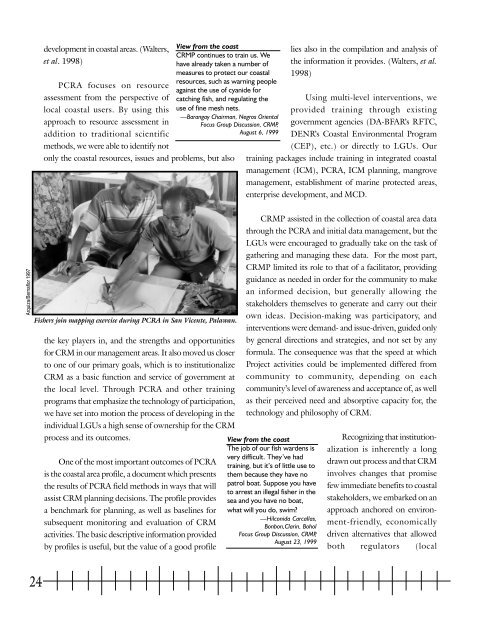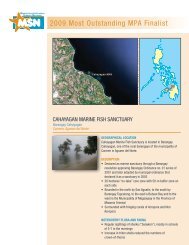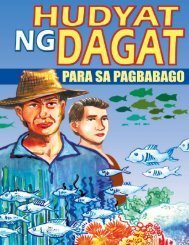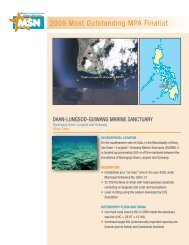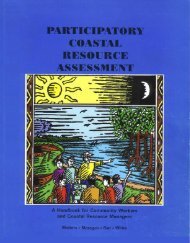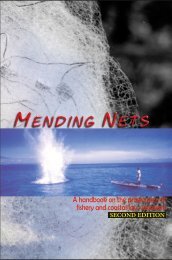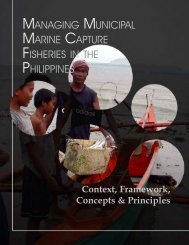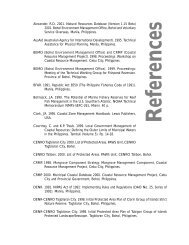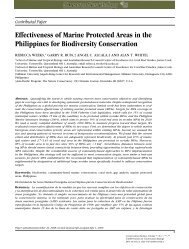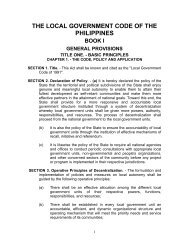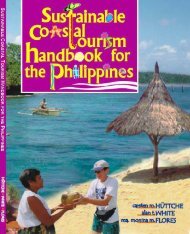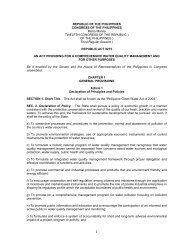Part 2 - Oneocean.org
Part 2 - Oneocean.org
Part 2 - Oneocean.org
- No tags were found...
Create successful ePaper yourself
Turn your PDF publications into a flip-book with our unique Google optimized e-Paper software.
development in coastal areas. (Walters,et al. 1998)View from the coastCRMP continues to train us. Wehave already taken a number ofmeasures to protect our coastalresources, such as warning peopleagainst the use of cyanide forcatching fish, and regulating theuse of fine mesh nets.—Barangay Chairman, Negros OrientalFocus Group Discussion, CRMP,August 6, 1999PCRA focuses on resourceassessment from the perspective oflocal coastal users. By using thisapproach to resource assessment inaddition to traditional scientificmethods, we were able to identify notonly the coastal resources, issues and problems, but alsolies also in the compilation and analysis ofthe information it provides. (Walters, et al.1998)Using multi-level interventions, weprovided training through existinggovernment agencies (DA-BFAR’s RFTC,DENR’s Coastal Environmental Program(CEP), etc.) or directly to LGUs. Ourtraining packages include training in integrated coastalmanagement (ICM), PCRA, ICM planning, mangrovemanagement, establishment of marine protected areas,enterprise development, and MCD.Arquiza/Bernaflor 1997Fishers join mapping exercise during PCRA in San Vicente, Palawan.the key players in, and the strengths and opportunitiesfor CRM in our management areas. It also moved us closerto one of our primary goals, which is to institutionalizeCRM as a basic function and service of government atthe local level. Through PCRA and other trainingprograms that emphasize the technology of participation,we have set into motion the process of developing in theindividual LGUs a high sense of ownership for the CRMprocess and its outcomes.One of the most important outcomes of PCRAis the coastal area profile, a document which presentsthe results of PCRA field methods in ways that willassist CRM planning decisions. The profile providesa benchmark for planning, as well as baselines forsubsequent monitoring and evaluation of CRMactivities. The basic descriptive information providedby profiles is useful, but the value of a good profileCRMP assisted in the collection of coastal area datathrough the PCRA and initial data management, but theLGUs were encouraged to gradually take on the task ofgathering and managing these data. For the most part,CRMP limited its role to that of a facilitator, providingguidance as needed in order for the community to makean informed decision, but generally allowing thestakeholders themselves to generate and carry out theirown ideas. Decision-making was participatory, andinterventions were demand- and issue-driven, guided onlyby general directions and strategies, and not set by anyformula. The consequence was that the speed at whichProject activities could be implemented differed fromcommunity to community, depending on eachcommunity’s level of awareness and acceptance of, as wellas their perceived need and absorptive capacity for, thetechnology and philosophy of CRM.View from the coastThe job of our fish wardens isvery difficult. They’ve hadtraining, but it’s of little use tothem because they have nopatrol boat. Suppose you haveto arrest an illegal fisher in thesea and you have no boat,what will you do, swim?—Hilconida Carcallas,Bonbon,Clarin, BoholFocus Group Discussion, CRMP,August 23, 1999Recognizing that institutionalizationis inherently a longdrawn out process and that CRMinvolves changes that promisefew immediate benefits to coastalstakeholders, we embarked on anapproach anchored on environment-friendly,economicallydriven alternatives that allowedboth regulators (local24


